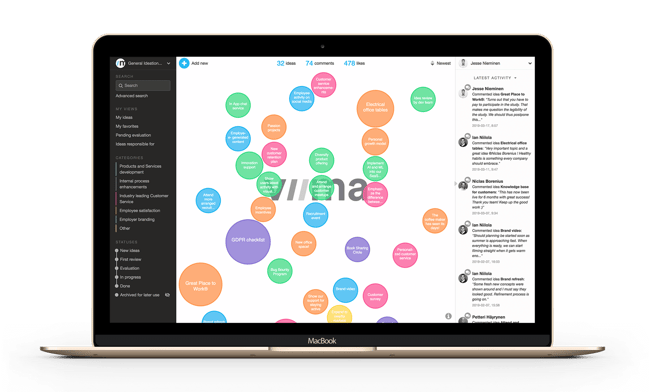Using Transparent Customer Feedback to Support Innovation
The ever-changing dynamic of customer relationships with brands has transformed the way organizations plan their growth. With the rise of numerous communication platforms and social media channels it seems easy to get feedback and understand customers’ needs and pain points.
But the easy access to information is deceiving.
Gathering and reading feedback doesn’t make it easy to filter the most important and valuable feedback that leads to improved and more innovative products and services.
Research shows that those who lead at customer experience are 32% more likely to create innovative products and services based on customer feedback, and 86% more likely to grow their revenue.
So, in today’s article we’ll explain how to best put to use customer feedback to support innovation. We’ll first explain the less obvious elements of customer feedback that lead to innovation, then list some of the challenges and mistakes typically associated with traditional methods of gathering and managing customer feedback and introduce an alternative way of doing things through transparent feedback.
Table of contents

Why is transparent customer feedback important for innovation?
The research cited above shows that companies that not only listen to their customers and employees, but also act on their feedback and enhance their experience, deliver greater value. These are customer-driven innovators with well-established feedback loops and learning systems that help them identify the best ideas, prioritize them and act on.
We shouldn’t generalize and think that all feedback will lead to innovation, especially in the case of disruptive or breakthrough innovations. However, customer feedback comes in handy for incremental and sustaining innovations, where continuous improvement plays a major role.
The key to leverage customer feedback is to have a transparent feedback system in place. By transparent feedback we refer to feedback that is by nature open and transparently visible for all stakeholders.
In other words, the difference with transparent feedback is that once a customer submits a piece of feedback, it's directly visible for everyone: all of the other customers, everyone in the company, the partners of the company, and yes, even their competitors.
Companies like Lego or Amazon have a long history of creating better, innovative products with help from their customers and transparent feedback and idea collection. When you start to actively listen to your customers you can learn more about the strengths and weaknesses of your products or services.
This is a gold mine for your development team or R&D department because sometimes their assumptions might be wrong or they could be so caught up in refining the tiniest details that they lose sight of the bigger picture, or the things that matter most for the end-users.
Just as valuable as listening to customer feedback is to listen to frontline employees. Those who are most often in contact with customers, should be part of your ideation process. No one knows customers’ pain points better than the employees who interact with them daily, whether this happens face to face or remotely.
Those who are most often in contact with customers, should be part of your ideation process.
 So, if you empower employees to provide additional context and document additional information from their interactions, you can get a better understanding of what customers want from their experience and identify the root cause of issues getting in the way. Collecting ideas from frontline employees is no walk in the park, especially in large organizations with thousands or hundreds of thousands of employees.
So, if you empower employees to provide additional context and document additional information from their interactions, you can get a better understanding of what customers want from their experience and identify the root cause of issues getting in the way. Collecting ideas from frontline employees is no walk in the park, especially in large organizations with thousands or hundreds of thousands of employees.
But with the right processes in place, a culture focused on continuous improvement and bottom-up approach to innovation, you can reap the benefits of customer feedback.
If we put all these together, it’s amazing to see how easy it is to improve bad feedback gathering practices by just utilizing concepts from co-creation or even open innovation.
Feedback should be fun, social, and most importantly, transparent.
By combining these three aspects you're definitely on to creating a more trustworthy and open relationship with your customers, which is the key in this era of dramatically diminished costs for finding an alternative. So how can transparent feedback improve your odds of succeeding at innovation?
Transparent feedback is easy to analyze
With transparent feedback you don’t have duplicates, since everything is already visible to everyone. So, it's easy to aggregate and categorize the feedback. It can even be done automatically for you, saving you the trouble of having to try to aggregate and categorize similar pieces of open-ended feedback together.
With this approach, you get both quantitative and qualitative feedback in an already processed format. Furthermore, you can combine those quantitative and qualitative findings with customer demographics and even filter out visual reports in real time on an aggregate or individual feedback level, leading to very interesting possibilities for finding new insights with very little extra effort.
Transparency leads to increased customer loyalty
By being transparent and open with your customers, you can show that you care about them, leading to increased loyalty. Transparency and the reply-once philosophy make it possible to ask the opinion of someone who knows about the topic.
So instead of that automated reply, you can have someone respond to them that can tell them whether their feedback is relevant for the company or not, and if not, why so. Even more interesting is the possibility of telling the customers what's happened to their feedback.
Has the idea been shot down? Is it under consideration? Or perhaps even implemented? What could possibly be better than to let a customer know that the product or service they personally requested is now available?
Just think about how amazing a service experience that will be for the customer and how much more you can sell that way.
Common mistakes when gathering customer feedback
Traditional methods of gathering feedback are asking customers to fill forms, sending emails, completing surveys and sometimes an online chat with a customer representative. For some years now, social media has also been used as a feedback tool, and many companies leverage those through social listening.
While these methods are not bad, they tend to be a closed communication between the customer and the system or in some cases a customer representative.
On one hand, only a few people might see the information and on the other, customers tend to be left in the dark after giving their feedback. In the case of social media platforms, these were not designed to be a feedback channel in the first place, and it’s a very reactive and resource intensive channel by nature.
Over the years and after working with customers worldwide, we identified the six most common mistakes that too many companies are doing when they gather feedback.

These six mistakes are also the reason too few companies get the ROI they expect for their investments in customer feedback. Each of them is worth a post of their own but let's try to keep it concise and see some practical ways of improving on those.
-
Using only quantitative or qualitative feedback
Ah, the age-old adage about which research method you should choose! Let's oversimplify their characteristics to a fault:
Qualitative
-
Good when you want to truly understand a complex issue, such as anything related to the behavior of people, or create something new (e.g. make assumptions).
-
Good for answering questions like why and how?
Quantitative
-
Good when you want to validate and test your assumptions
-
Good for answering questions like what, how much?
So what does that mean for customer feedback?
Well, obviously you want to try to understand your customer in the context of your business as well as possible. Both of these are very complex issues in themselves, and you typically want to use that feedback to try to improve your business and create something new so clearly a qualitative approach is required.
We’d argue that because of these arguments, qualitative is the more important of the two. However, typically you also want to set up some kind of quantitative tests to see whether the assumptions you made based on the qualitative data are also valid on a larger scale and whether the actions you've done based on the previous qualitative feedback have made a difference.
So ideally, you want to include both quantitative and qualitative approaches in your customer feedback process.
2. Asking for satisfaction as opposed to significance
Let's take the classic example of a customer satisfaction survey where you rate how good the individual components of your customer experience were on some scale.
Although valuable information in itself for trying to perceive how the different components of your customer service are performing, these questionnaires have one fundamental flaw in them. They don't ask the customer what they find important.
Let's say that you run a restaurant and a customer rates your interior design as a 2 out of 5 and your quality of food as 3 out of 5. What does that number really mean? How can you use it to make your customer experience better? Does that mean that you should invest more in interior design than on your food? Most likely it doesn't. I'd guess that most people care more about the food than they do about the interior design, you just can't know that based on the survey.
Typically you'll have lots of ideas on how to improve the different aspects of your business but it's very hard to prioritize those ideas. Obviously, the best way to prioritize them is to figure out what it is that really matters for your customers.
3. Obsessing over KPIs
As mentioned above, what does it really mean that the customer rates your interior design as a 2? Or that your Net Promoter Score (NPS) is 87? What do those really mean for your business?
Sure, there has been a lot of talk about NPS correlating with growth in the long term, but the fact of the matter is that even though this might work as an easily understandable KPI for the frontline employees, or as a "proof" that you're heading in the right direction for your boss giving you some piece of mind, what really matters is that you're continuously able to improve your customer experience.
Make sure you're continuously improving your customer experience.
To be able to do that, you can't just blindly rely on KPIs but instead have to dig deeper and really try to understand your customer in order to come up with the best solution for their problems and desires.
The fundamental problem in using quantitative KPIs that are only based on people's self-declared opinions, such as NPS, is that they are by nature, never correct. This leads to a number of issues ranging from cultural and individual biases all the way to employees rigging the score to reach targets.
If you want to ask something from the customers, ask what's important for them. If you want to have KPIs, measure their actual behavior in whatever's important, not their perceived satisfaction.
4. Not acting on the feedback
This one might sound trivial, but all too often do companies ask for feedback and then just never do anything about it afterwards.
In the worst case, the feedback might even be stuck inside the customer support function so that it never even reaches the ears of the decision makers. But even if it does, it's still all too common that those decision makers just consider it as a necessary evil, only acting on it if it's perceived as urgent.
Often, it's also the organization that gets in the way. You might not have the authority or the budget to actually make the changes that customers are wishing for, in which case you'll have to sell these improvements to your boss separately.
Although generally speaking, we believe that for many businesses NPS isn't all that useful, it is at the very least good for one thing: it's simple and (seemingly) easy-to-understand, which can help you have both top management and frontline employee buy-in for customer experience, which again can really help your effort in being able to later on act on the feedback you've received.
5. Not communicating
Whenever a customer gives you feedback, they basically do it because they're annoyed and want an outlet or because they care about your business enough to want to help you improve.
Either way, it's crucial that the customer gets your response and hears that you're going to do something with their feedback. Also, if you won't do anything, they want to know about that decision. If you just let people know that you care and are doing your best, you're already 90% there to win the customers’ heart.
On the other hand, if the customer never hears back from you, or even worse, just gets an auto-response saying: "Your feedback is very important to us...", you've not only lost a great chance to make a positive impact but have caused a very bad experience for the person who in the end pays your salary.
6. Not making it a continuous process
The average company only does two things related to customer feedback: the plain old feedback form (that few people respond to) and a yearly customer satisfaction survey.
The second mistake on the list already discussed the disadvantages of asking for satisfaction but on top of that, there's another crucial issue with an annual customer satisfaction survey: it's annual.
You probably wouldn't leave bugs in your software unfixed for an entire year so why would you do that for the things your customers care enough about to complain.
How to gather transparent customer feedback
The answer lies between getting feedback from customers and engaging employees in the process. So, it’s about uncovering both the "what" and the "why" of customers behavior and that requires more effort than simply asking them to fill a survey.
If you’re working to systematically gather feedback and listen to employees and customers you are more likely to improve the customer experience and therefore, continuously improve on your service and products.
So, how does this look in practice?
First thing first, make sure you have the capabilities and the processes that allow frontline employees to not just collect feedback, but also address local customer issues.
At an organizational level, leaders should communicate the roadmap of products and services, the development plan and how those are aligned with the vision and mission of the company.
Essentially, you want them to know which feedback is high priority and how to handle less important issues. This means that employees should be accountable for their work and embed the mindset of continuous improvement in their every-day work.
 Create clear guidelines on how to gather and transfer feedback. Create categories, label, and prioritization models. An idea management tool is perfect in such situations. We might be biased, but we’ve seen with our customers how easier it became for them to improve on their customer experience and internal communication by creating transparent processes for gathering feedback.
Create clear guidelines on how to gather and transfer feedback. Create categories, label, and prioritization models. An idea management tool is perfect in such situations. We might be biased, but we’ve seen with our customers how easier it became for them to improve on their customer experience and internal communication by creating transparent processes for gathering feedback.
In short, you want to check at least these three things: engage different employees in the process of gathering feedback, designate accountability to resolve systematic issues and communicate guidelines to gather feedback as well as actions taken based on their feedback.
Conclusion
Today, customers have come to demand transparency and excellent customer service. Even so, you should remember that acquiring a new customer is at least 5 times as expensive as keeping an existing customer. So, make sure you're not wasting money on customer acquisition if your funnel is leaking from the other end!
In the end, whatever you're doing in the area of customer feedback, we hope you'll keep these points in mind and consider making your customer interaction more transparent. But most importantly, remember that listening is not enough. To harness the benefits of customer and employee feedback you have to take action.
Last, but not least, keep in mind that innovation takes time so you need to take it step by step. Gathering feedback and acting on it is one of those steps. If you want to learn more about how an innovation management tool can help you out, book a demo and see how it works in practice.
Interested in Innovation and Leadership?
Subscribe to our blog to get the latest stories on innovation, leadership and culture straight to your inbox.





